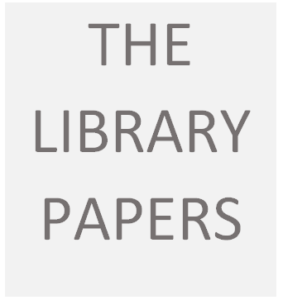Connect and Wonder
Journal Entry 1
Connect
When I was in public school, I remember there were lots of opportunities for faux inquiry, described accurately by Donham as the “locate information—cut and clip—report” model (Donham, 2010). I don’t remember ever inquiring into a topic I chose myself. I do remember on my own, outside of school and long before the internet, following threads of interest—looking for more titles by the same author, looking for more titles in the same genre, finding articles about the genre itself, and then finding how-to books for building doll furniture, drawing human figures, writing novels, cooking. But I didn’t think of these informal investigations as ‘learning,’ as ideas to be pursued and developed further: more like areas of passing interest. The real learning happened in school; it started with the assignment from the teacher, and it ended with the report I submitted or the test I wrote on the topic.
Even as an undergraduate in university I don’t remember doing anything that resembled what’s being described in these readings. I did learn to summarise and synthesise information, but while I recognise that this is an important skill, it doesn’t really matter how well you do it if there’s no larger context in which you plan to use it, no purpose for using it. It wasn’t until I went to write my MA thesis that I was able to do a purposeful inquiry based on my own self-directed interests and I loved it. That was when I first realized, to my surprise, that the adjective ‘creative’ could apply to me.
When I say “I loved it,” I should qualify—I loved it 50% of the time. The other 50% I was scared, confused, unsure and wandering around in what felt like the wilderness. This despite the frequent check-ins with my supervisor which are supposed to keep these projects on track. A certain amount of confusion is a good thing—if your learning doesn’t take you into unfamiliar territory, it isn’t really learning, is it? But too much confusion is overwhelming—you are too busy trying to orient yourself to be able to move forward, to absorb new information. And all the while, you know you are accountable for delivering a product in the end. How will you get there from here? So while there are pleasures in inquiry learning, there are pitfalls for the unwary. Bearing this experience in mind, I have approached this topic, this course, these readings with a question: how can you keep inquiry as an open and creative process while giving enough guidance to support students as they go through the stages?
Wonder
Finding questions: One of my questions about launching inquiries for primary and secondary students has to do with supporting them to find sustainable questions to investigate. The central thing about inquiry is that it is based on a question, right? But in my experience, you ask better questions when you have some idea of what kind of questions can be asked. The point of the graduate courses I took, and especially the directed readings which let me home in with progressively sharper focus on my research area, was to give me the background/overview of the field which I would need in order to situate myself within it. I think this is what the “Connect and Wonder” stage of the BCTLA Points of Inquiry model is for. I also like what Fontichiaro says about searching for questions—”Saving time for exploration, presearch, and noodling through encyclopedias or other foundational resources before prompting for student questions will raise the caliber of the questions students create” (Fontichiaro, 2015). In other words, it is not reasonable to expect students to be able to ask the higher-level questions from Bloom’s Taxonomy that will lead to critical thinking and original creation until they’ve had a chance to ask and answer the lower-level questions.
Three documents I will use in designing my inquiry project are Stripling’s Curriculum connections through the library (2003), the BCTLA Points of Inquiry, and Alberta Learning focus on inquiry (2004). I like Stripling’s discussion about recognizing that inquiry in schools is discipline-based. It is important to help students make connections to the curriculum of a given discipline as they pursue their inquiries, connections which also link to the particular communities who might use the knowledge. I like the BCTLA Points of Inquiry model because it is succinct, it includes detailed guidance about the skills students should be acquiring at different learning levels as they go through each stage of the inquiry, and because of its emphasis on the creative process of finding questions in the first “Connect and Wonder” stage. The focus on inquiry document takes a multi-level approach to inquiry which includes scaffolded instruction and metacognitive awareness throughout the process. Step 1 of this model is ‘Planning,’ which includes initial exploration of the topic, but at the same time asks inquirers to start thinking about the audience, the presentation format, and the assessment criteria. (See the table below for a comparison of the features of each model). I believe that both of these considerations—connecting and planning—will help students identify a sustaining purpose for the eventual product: it is not just any question you are investigating; it is not just anyone to whom you will be talking about it, and it’s not just any old way that you will be explaining it.
Some other useful tips from Fontichiaro:
- Remember that hard thinking takes time and assign “think about this” time for homework.
- Provide prompts for this ‘thinking’ time, such as, ”Talk to at least one other person about your project for no more than thirty seconds.” (Fontichiaro, 2015).
Both of these exercises would be helpful in crystallizing thinking and both of them are low-threshold, low-stress introductions to finding a topic.
An additional question, which I wasn’t planning to ask here, until it came up in the class discussion: how do the diagnostics students are increasingly subjected to affect creativity? This isn’t really covered in the readings, and yet it is a question I had as well: if students lack the basic literacy skills of decoding and fluency (which diagnostics are intended to identify), how can they undertake research and investigation. I think that since class size and composition guidelines were eliminated, classroom teachers have been thrown back onto their own resources in trying to support students with learning difficulties and there is now a need to recognise that it’s not necessary to be all things to all students—we have to relearn how to rely on resource teachers, how to design collaboration that includes their contributions too.
My inquiry topic, whatever it turns out to be, will need to be structured in order to support students with learning difficulties no less than students without.
Comparison of two Inquiry Models
BCTLA Points of Inquiry
- Connect and Wonder
- Investigate
- Construct
- Express
- Reflect
Alberta Learning Focus on Inquiry
- Planning
- Retrieving
- Processing
- Creating
- Sharing
- Evaluating
Works Cited
Alberta Learning. (2004). Focus on Inquiry. Edmonton, AB: Alberta Learning.
Donham, J. (2010). Deep learning through concept-based inquiry. School Library Monthly 27(1): 8-11.
Ekdahl, M., Farquharson M., Robinson, J., and Turner, L. (2010). Points of Inquiry: A Framework for Information Literacy and the 21st Century Learner. Vancouver, BC: BCTF/ BC Teacher-Librarians’ Association.
Fontichiaro, K. (2015). Nudging toward inquiry: “What’s inquiry? Well, I’ll know it when I see it.” School Library Monthly 31(4): 49-51.
Stripling, B. K. (2003). Inquiry-based learning. In Curriculum Connections through the Library. Eds. B. K. Stripling & S. Hughes-Hassell. Westport, CT: Libraries Unlimited.


